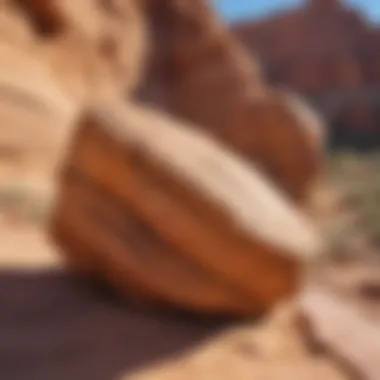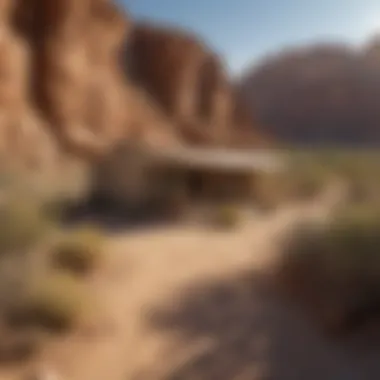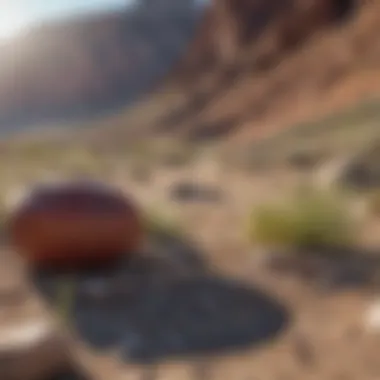Unveiling the Geological Wonders of Cricket in Utah: An Intriguing Exploration


Rock and Fossil Identification
Utah is a geological wonderland, teeming with a diverse array of rocks and fossils waiting to be explored by avid enthusiasts. When it comes to identifying these specimens, one must be well-versed in the different types that can be found across the state. From sedimentary to igneous to metamorphic rocks, Utah boasts a fascinating mix of geological formations that provide a rich tapestry for collectors to uncover. Fossils, ranging from ancient marine creatures to dinosaur remnants, add another layer of intrigue to the state's geological landscape.
To effectively pinpoint and categorize these rocks and fossils, collectors should pay attention to specific characteristics such as color, texture, hardness, and any distinctive markings or imprints. Utilizing tools like magnifying glasses, rock hammers, chisels, and field guides can aid in the identification process, ensuring accuracy in classifying these geological treasures.
Collecting Tips and Techniques
For rock and fossil collectors venturing into Utah's geological realm, mastering the best practices for collecting is essential in maximizing the experience. Identifying prime collecting sites is the first step towards unearthing hidden gems within the state. From ancient seabeds to fossil-rich sedimentary rocks, Utah offers a diverse range of locations where enthusiasts can discover unique specimens.
Once at a collecting site, it's crucial to handle specimens with care and respect. Safely extracting rocks and fossils involves using appropriate tools and techniques to avoid damage to both the specimens and the surrounding environment. By adhering to ethical collecting practices and respecting natural habitats, collectors can ensure the preservation of Utah's geological heritage for future generations.
Preservation and Display
After a successful collecting expedition, the next step is preserving and showcasing the acquired rocks and fossils. Employing techniques such as cleaning, stabilizing, and protecting specimens is key to maintaining their integrity over time. Utilizing proper storage methods, such as acid-free containers or padded display cases, helps prevent deterioration and ensures longevity.
When it comes to displaying these geological treasures, creativity knows no bounds. From themed collections to dynamic arrangements that highlight the specimens' unique features, collectors can breathe life into their displays. Incorporating lighting, labeling, and informative placards enhances the viewer's experience, turning a simple exhibit into an immersive journey through Utah's geological wonders.
Geological Insights
Delving deeper into Utah's geological landscape unveils a wealth of insights into the state's natural history. Geological formations and processes, shaped over millions of years, provide a window into the Earth's evolving story. Understanding the historical significance of rocks and fossils offers a glimpse into past environments and ecosystems that once thrived in Utah.
Throughout the years, notable discoveries in the field of geology have highlighted Utah's importance as a hotspot for scientific exploration. From uncovering rare fossils to deciphering ancient climates through rock formations, researchers and collectors alike continue to unravel the secrets embedded in Utah's geological tapestry.
Introduction
In this article on Exploring Cricket in Utah from a Geological Perspective, we embark on a profound journey unveiling the intrinsic connection between the geological landscape of Utah and the enchanting world of crickets. Delving into this captivating subject sheds light on how geological formations and environmental factors shape the habitats and behavior of these fascinating creatures. By examining the geological significance of cricket ecosystems in Utah, we gain a deeper appreciation for the intricate interplay between nature's wonders and biodiversity.
Overview of Cricket


Cricket, a unique insect species belonging to the Gryllidae family, holds a significant place within the ecosystem of Utah. With their distinctive chirping sounds filling the air during summer evenings, crickets are more than just background noise; they serve as vital components in the local food chain, contributing to the delicate balance of Utah's biodiversity. Understanding the lifecycle, behavior, and ecological importance of crickets enriches our appreciation for these often-overlooked creatures. This section will encompass a detailed exploration of the characteristics, habits, and ecological roles of crickets in Utah, providing keen insight into their significance within the state's natural ecosystem.
Geological Significance
In the comprehensive exploration of cricket in Utah from a geological perspective, the significance of the state's geological features cannot be understated. Utah's unique geological formations not only provide a stunning backdrop for cricket habitats but also play a crucial role in shaping the diverse ecosystems where crickets thrive. The intricate relationship between the geological landscape and the cricket populations offers a fascinating insight into the interconnectedness of nature. By delving into the geological significance of Utah in relation to crickets, we can uncover the hidden complexities and marvels of this mesmerizing ecosystem.
Cricket Habitats in Utah
Desert Environments
Within the vast expanse of Utah's desert landscapes lie some of the most intriguing cricket habitats. These arid regions are home to a myriad of cricket species adapted to the harsh conditions prevalent in desert environments. The unique feature of desert environments, such as sparse vegetation and extreme temperatures, presents both challenges and opportunities for crickets. Despite the harshness of the desert climate, crickets have developed remarkable survival strategies that make them an essential component of Utah's biodiversity. Exploring the interaction between crickets and the desert environment unveils a rich tapestry of adaptation and resilience.
Mountainous Regions
The mountainous regions of Utah offer a contrasting habitat for crickets, characterized by rugged terrain and diverse elevations. The high altitude and varied topography present crickets with a range of microclimates to inhabit and thrive in. Mountainous regions provide unique pockets of biodiversity for crickets, fostering a rich tapestry of species diversity. The significance of these elevated landscapes in shaping the evolution and distribution of crickets adds a layer of complexity to their ecology, highlighting the intricate relationship between topography and cricket habitats.
Wetlands and Riparian Areas
Utah's wetlands and riparian areas serve as vital ecosystems for a variety of wildlife, including crickets. These habitats, characterized by abundant water sources and lush vegetation, create ideal conditions for certain cricket species to flourish. The dynamic interplay between water availability, vegetation cover, and climatic factors in wetlands and riparian areas influences the abundance and distribution of crickets. Exploring the role of these aquatic habitats in supporting unique cricket populations sheds light on the complexity of ecological relationships within Utah's diverse landscape.
Impact of Geological Factors
Climate
The climate of Utah plays a pivotal role in shaping the distribution and behavior of cricket species across various habitats. From the scorching heat of the desert to the cool mountain air, crickets have adapted to thrive in a spectrum of climatic conditions. Understanding how different climatic factors influence cricket ecology provides valuable insights into their resilience and evolutionary success. By examining the interconnectedness between climate patterns and cricket behavior, we can unravel the intricate web of relationships that define Utah's cricket populations.
Topography
The diverse topography of Utah, ranging from arid deserts to snow-capped mountains, presents a mosaic of habitats for crickets to inhabit. The topographical features of the landscape influence microclimates, vegetation cover, and resource availability, shaping the abundance and diversity of cricket species. Crickets have evolved unique physiological and behavioral adaptations to thrive in varied topographic settings, highlighting the adaptive flexibility of these fascinating insects. Exploring the impact of topography on cricket distribution offers a glimpse into the interplay between landforms and biodiversity.
Soil Composition


The composition of soil in Utah's diverse habitats exerts a significant influence on the ecology and distribution of cricket populations. Different soil types, ranging from sandy desert soils to rich forest soils, provide varying substrates for crickets to lay eggs, seek shelter, and forage for food. The nutrient content, pH levels, and moisture retention capacity of soil influence the abundance and diversity of cricket species in specific habitats. Investigating the role of soil composition in shaping cricket communities unveils the intricate connections between edaphic factors and insect ecology within Utah's geological tapestry.
Biodiversity and Ecology
Exploring the biodiversity and ecology of crickets in Utah provides a fascinating look into the intricate web of relationships that exist within this unique ecosystem. The diversity of cricket species in Utah is not just a matter of numbers but a reflection of the interconnectedness of various elements in the region's environment. Utah's biodiversity is a result of its varied terrain, ranging from desert environments to mountainous regions and wetlands, each offering a distinct set of conditions that support different species of crickets.
The presence of diverse cricket species in Utah is indicative of a healthy and balanced ecosystem. Each species plays a crucial role in maintaining the ecological equilibrium by contributing to processes such as nutrient cycling, pollination, and pest control. Understanding the biodiversity and ecology of crickets in Utah is essential for comprehending the broader picture of the state's natural world.
The benefits of studying the biodiversity and ecology of cricket species in Utah extend beyond mere academic interest. By delving into the intricate relationships between crickets and their surroundings, researchers can gain insights that have practical implications for conservation efforts and ecosystem management. The knowledge derived from studying cricket species diversity can inform conservation strategies and help preserve Utah's unique biological heritage for future generations.
Diversity of Cricket Species
The diversity of cricket species in Utah is a testament to the state's rich and varied habitats. From the arid deserts to the lush wetlands, each environment harbors a unique assemblage of cricket species adapted to thrive in specific conditions. Utah boasts a remarkable array of cricket species, each with its own set of distinctive characteristics and behaviors.
In the desert environments of Utah, cricket species have evolved to withstand extreme temperatures and scarce water resources. These desert-adapted crickets exhibit fascinating behavioral traits, such as burrowing to escape the heat or surviving long periods without water. In contrast, crickets inhabiting mountainous regions display adaptations suited to colder climates, utilizing crevices and vegetation for protection.
Wetlands and riparian areas in Utah offer a different set of challenges and opportunities for cricket species. Crickets found in these habitats are adept swimmers and may exhibit unique behaviors related to water, such as stridulating while submerged. The diversity of cricket species across Utah's varied landscapes underscores the adaptability and resilience of these fascinating insects.
Research and Conservation
In this article, the focus is on the essential aspect of research and conservation in the realm of exploring cricket in Utah from a geological standpoint. Research plays a pivotal role in uncovering the intricate relationships between crickets and their habitats, contributing significantly to our understanding of these fascinating creatures. Conservation efforts are crucial in preserving the delicate balance of ecosystems where crickets thrive, ensuring their continued presence in Utah's diverse landscapes. By delving into the specifics of research and conservation, this article aims to shed light on the importance of protecting Utah's cricket populations for future generations to appreciate and study.
Scientific Studies on Utah's Crickets
Habitat Preferences
Habitat preferences are a critical aspect of scientific studies on Utah's crickets, dictating their distribution and abundance within different geological settings. Understanding the specific habitat requirements of various cricket species is fundamental in conserving their populations and maintaining biodiversity. By exploring the unique habitat preferences exhibited by Utah's crickets, researchers can gain valuable insights into the factors shaping their ecology and behavior. Emphasizing the significance of habitat preferences in this article underscores the intricate interplay between crickets and their surroundings, elucidating key factors that influence their survival and reproductive success.
Behavioral Patterns
The behavioral patterns of Utah's crickets serve as vital indicators of their adaptability and ecological roles within their environments. By studying the behavioral responses of these insects to varying stimuli and conditions, researchers can unravel the complex dynamics governing their interactions with other species and their surroundings. Highlighting the diversity of behavioral patterns observed in Utah's crickets enhances our understanding of the intricate strategies they employ for foraging, communication, and survival. Exploring the nuances of these behavioral patterns in this article offers a nuanced perspective on the fascinating world of cricket behavior and its implications for ecological research.


Population Dynamics
Investigating the population dynamics of crickets in Utah provides critical insights into their demographics, abundance trends, and responses to environmental changes. By examining population fluctuations, age structure, and reproductive rates, researchers can assess the long-term sustainability of cricket populations in the face of evolving geological conditions. Analyzing the factors influencing population dynamics offers valuable data for conservation efforts aimed at preserving cricket diversity and ecosystem resilience. Exploring the intricacies of population dynamics in this article underscores the dynamic nature of cricket populations and the importance of monitoring their numbers for effective conservation strategies.
Conservation Efforts
Challenges and Threats
Addressing the challenges and threats faced by Utah's cricket populations is essential for devising effective conservation strategies to mitigate risks and safeguard their habitats. Climate change, habitat loss, and pollution pose significant threats to cricket ecosystems, impacting their survival and biodiversity. By identifying and understanding these challenges, conservationists can prioritize conservation actions to protect vulnerable cricket species and their habitats. Delving into the specific challenges and threats confronting Utah's crickets in this article highlights the urgent need for collaborative efforts to address environmental pressures and ensure the preservation of these fascinating insects.
Protective Measures
Implementing protective measures is crucial in securing the future of Utah's cricket populations and their habitats against potential threats and disturbances. Conservation initiatives, habitat restoration projects, and community engagement play vital roles in safeguarding cricket diversity and promoting ecosystem health. By advocating for proactive conservation measures, this article aims to inspire conservationists and stakeholders to take concrete actions to preserve Utah's valuable cricket populations for the benefit of both present and future generations. Exploring the efficacy of protective measures in this article underscores the tangible impact of conservation efforts in ensuring the continued existence of Utah's diverse cricket communities.
Cultural Perspectives
In the realm of exploring cricket in Utah from a geological perspective, cultural perspectives play a vital role in enriching our understanding of the interconnectedness between nature and human society. Examining the traditional significance attributed to crickets sheds light on the deep-rooted relationship between these insects and the local communities in Utah. The cultural perspectives intertwined with cricket observation offer a fascinating glimpse into ancient beliefs, rituals, and folklore that have been passed down through generations.
Exploring the traditional significance of crickets in Utah unveils a tapestry of narratives that highlight the symbolic importance of these creatures in various cultural contexts. From Native American tribes to early settlers, crickets have held symbolic value as harbingers of good luck, resilience, and even messages from the spirit world. Understanding these traditional beliefs provides a unique insight into how human societies have harmonized with the natural world, viewing crickets not merely as insects but as significant cultural symbols.
Traditional Significance of Crickets
Delving deeper into the traditional significance of crickets reveals a mosaic of rich cultural traditions and practices that have revered these insects throughout history. Among Native American tribes in Utah, crickets have been revered for their ability to communicate with ancestral spirits and serve as protectors of crops and homes. The chirping of crickets is believed to be a form of communication between the earthly realm and the spiritual realm, signifying harmony and balance in nature.
Furthermore, early settlers in Utah embraced the presence of crickets in their folklore, attributing qualities of resilience and perseverance to these small creatures. Stories of crickets overcoming various challenges resonated with pioneers and became symbolic of endurance and hope in the face of adversity. The traditional significance of crickets in Utah transcends mere entomology, portraying a nuanced narrative of cultural values and beliefs that continue to resonate in contemporary society.
Conclusion
In the intricate tapestry of cricket exploration in Utah through a geological lens, the Conclusion section serves as the pivotal piece that brings together the various facets discussed throughout the article. As we reflect on the geological significance, biodiversity, conservation efforts, and cultural perspectives surrounding cricket in Utah, it becomes abundantly clear that these tiny creatures play a much larger role in the ecosystem than meets the eye. By highlighting the key takeaways presented in this article, we can appreciate the interconnectedness between geological formations, biodiversity, and human interactions with the environment.
Moreover, the Conclusion section encapsulates the essence of why understanding and preserving Utah's cricket populations matter. It emphasizes the delicate balance between geological factors, wildlife habitats, and human activities in shaping the landscape in which crickets thrive. By pinpointing the critical need for sustainable practices and conservation efforts, this section underlines the necessity of continued research and awareness for the long-term preservation of cricket populations in Utah.
Implications for Future Research
Delving deeper into the implications for future research in the realm of cricket exploration in Utah unearths a realm of exciting possibilities and challenges alike. As researchers strive to unravel the intricate relationships between geological features, climate patterns, and cricket habitats, there is a wealth of untapped knowledge waiting to be discovered. From investigating the impact of climate change on cricket populations to examining the adaptation strategies of different cricket species, the future of cricket research in Utah is ripe with potential.
Furthermore, future research endeavors need to address the gaps in knowledge surrounding the behavioral patterns and population dynamics of Utah's crickets. By honing in on these aspects, researchers can better understand the resilience of cricket populations in the face of environmental challenges and human-induced pressures. This deeper insight will not only enhance our appreciation for the natural world but also guide conservation efforts and policy decisions to safeguard Utah's diverse cricket communities for generations to come.







